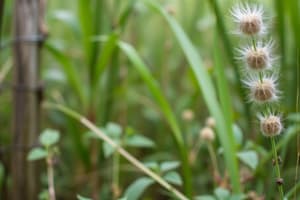Podcast
Questions and Answers
Which biome is characterized as a cold desert with no trees?
Which biome is characterized as a cold desert with no trees?
- Tundra (correct)
- Grasslands
- Boreal
- Temperate deciduous
The biosphere includes only the atmosphere and hydrosphere.
The biosphere includes only the atmosphere and hydrosphere.
False (B)
What is the study of how organisms interact with each other and the environment called?
What is the study of how organisms interact with each other and the environment called?
Ecology
In the carbon cycle, the major reservoir of carbon is the ______.
In the carbon cycle, the major reservoir of carbon is the ______.
Match the following biomes with their characteristics:
Match the following biomes with their characteristics:
Which term refers to the number of different types of species in an area?
Which term refers to the number of different types of species in an area?
Sustainability refers to managing resources without exhausting them.
Sustainability refers to managing resources without exhausting them.
The ______ is the layer of gases surrounding Earth.
The ______ is the layer of gases surrounding Earth.
What is the primary function of nitrogen fixation?
What is the primary function of nitrogen fixation?
Producers are organisms that cannot produce their own food.
Producers are organisms that cannot produce their own food.
What is the main pigment involved in photosynthesis?
What is the main pigment involved in photosynthesis?
In a food chain, primary consumers eat ________.
In a food chain, primary consumers eat ________.
Match the following terms with their definitions:
Match the following terms with their definitions:
Which of the following is NOT a type of symbiotic relationship?
Which of the following is NOT a type of symbiotic relationship?
In a typical food pyramid, energy is transferred in a 10% efficiency rate from one trophic level to the next.
In a typical food pyramid, energy is transferred in a 10% efficiency rate from one trophic level to the next.
What happens to the remaining 90% of energy not passed on to the next trophic level?
What happens to the remaining 90% of energy not passed on to the next trophic level?
Flashcards
Holistic
Holistic
Considering the whole system and all its interconnected parts.
Stewardship
Stewardship
Taking responsibility for caring for and managing the environment.
Environment
Environment
All living and non-living things interacting on Earth.
Sustainable
Sustainable
Signup and view all the flashcards
Ecosystem
Ecosystem
Signup and view all the flashcards
Biotic
Biotic
Signup and view all the flashcards
Abiotic
Abiotic
Signup and view all the flashcards
Population
Population
Signup and view all the flashcards
Nitrogen Fixation
Nitrogen Fixation
Signup and view all the flashcards
Photosynthesis
Photosynthesis
Signup and view all the flashcards
Cellular Respiration
Cellular Respiration
Signup and view all the flashcards
Food Chain
Food Chain
Signup and view all the flashcards
Food Web
Food Web
Signup and view all the flashcards
Trophic Level
Trophic Level
Signup and view all the flashcards
Symbiosis
Symbiosis
Signup and view all the flashcards
Carrying Capacity
Carrying Capacity
Signup and view all the flashcards




